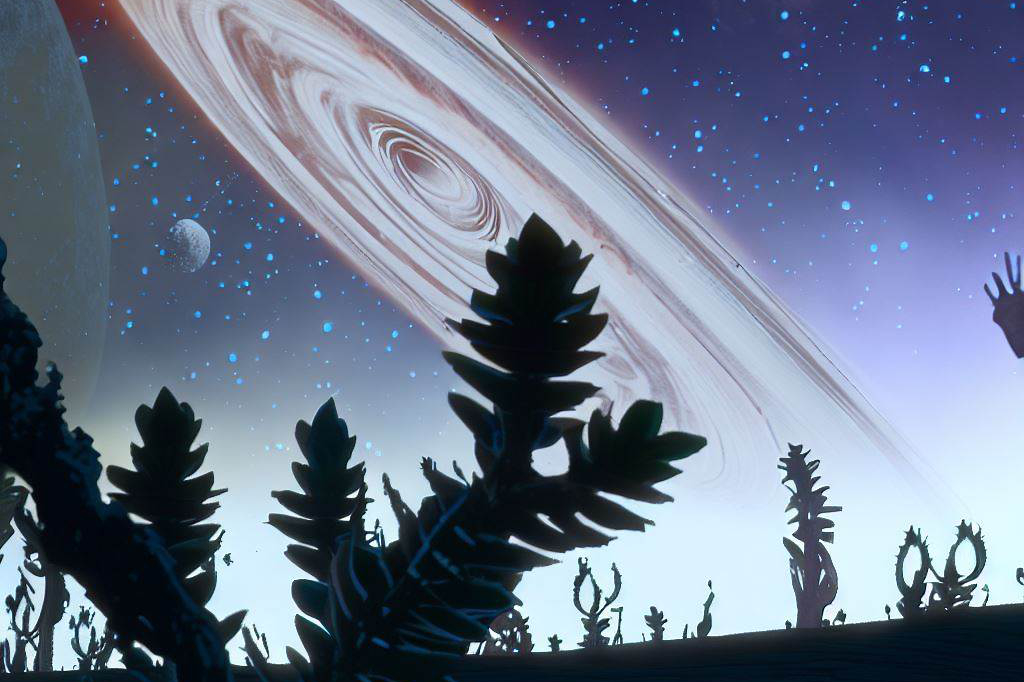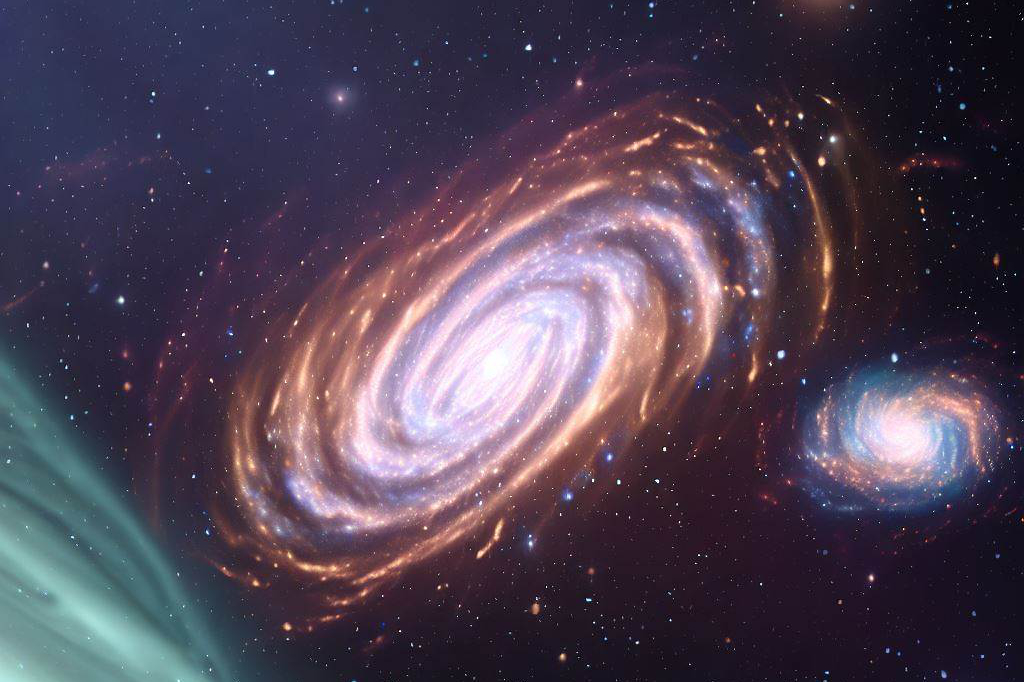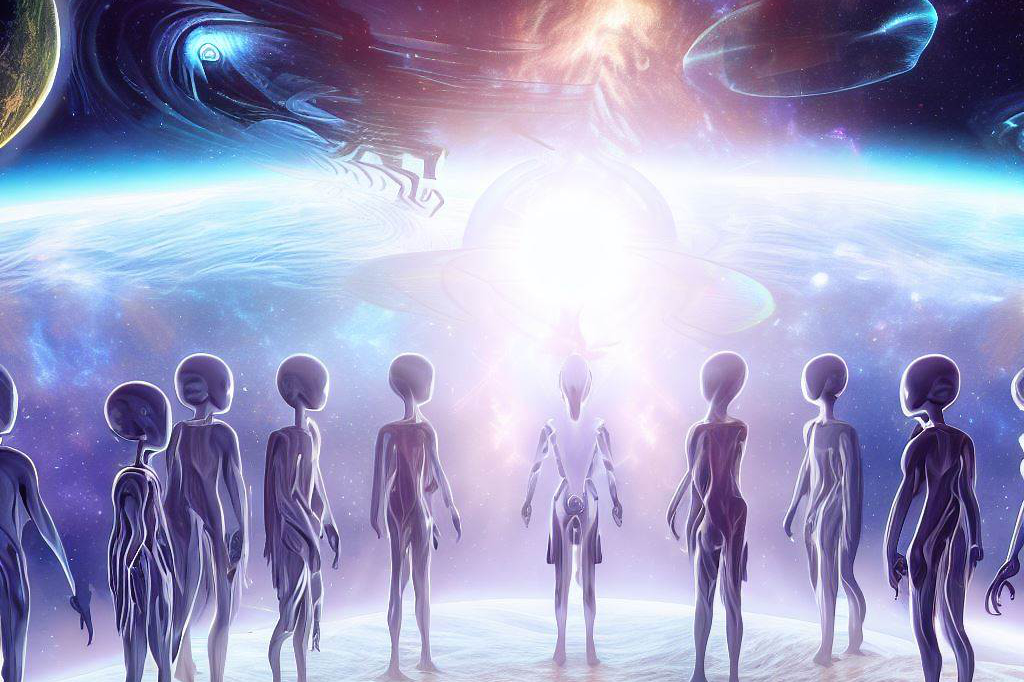The Milky Way Galaxy and its Size
The Milky Way galaxy is our home. It is a giant, spiral-shaped collection of stars, gas, dust, and dark matter that stretches across 100,000 light-years. That’s right – the Milky Way is so big that it takes light 100,000 years to travel from one end to the other!
Our Sun is just one of the hundreds of billions of stars in the Milky Way.
To put the size of the Milky Way into perspective: imagine you were traveling at the speed of light (which is approximately 186,000 miles per second) – it would take you about 100,000 years to cross from one side of our galaxy to the other. That’s how massive this thing is!
The Possibility of Life Beyond Our Galaxy

The question on everyone’s mind: Is there life beyond our galaxy? Well, we know that life has developed here on Earth, and we also know that there are billions of other galaxies out there with an untold number of stars and planets. So it would seem logical to assume that at least some percentage of those planets could be habitable.
Today we have telescopes and technology advanced enough to detect exoplanets – planets outside our solar system – which has given us a glimpse into just how many potentially habitable worlds might exist out there. Additionally, SETI (Search for Extraterrestrial Intelligence) scientists have been listening for radio signals from space for decades in hopes that they might discover signs of intelligent life elsewhere in our galaxy or even beyond it.
As far as we know now though – Earth remains the only planet where life exists. But with so many possibilities out there in space waiting to be explored – who knows what kind of incredible discoveries await us?
Eh, what’s a Solar System?
Note: so as not to confuse matters, here’s an easy explanation of ‘solar system’ as mentioned above, and in relation to what we’ve come to learn about the Milky Way galaxy:
Imagine the Milky Way galaxy as a giant city with billions of houses. Each of these houses is a star, and our Sun is just one of these many stars in the city.
Now, surrounding some of these stars (or houses), you have families living inside. In the context of space, a family would be what we call a “solar system.”
A solar system is a collection of planets, moons, asteroids, and other space rocks that orbit, or go around, a star (or multiple stars).
Our sun has its own solar system, which includes planets like Earth, Mars, Jupiter, and others.
So, in summary:
- Milky Way Galaxy: A vast city filled with billions of houses (stars).
- Solar System: A family (group of planets and other objects) living around one of those houses (stars).
And Earth, the planet we live on, is just one member of the solar system family that orbits our sun, which is one of the billions of stars in the Milky Way galaxy city.
What are other galaxies?

When we look up at the sky on a clear night, we can see a handful of bright stars scattered throughout the darkness. However, these stars aren’t just floating in space by themselves. They’re part of complex and massive structures called galaxies.
A galaxy is essentially a collection of stars, gas, dust, and dark matter all held together by gravity.
The Milky Way galaxy is our home galaxy – it’s where Earth and our solar system reside.
But it’s not the only galaxy out there in the universe. In fact, there are millions upon millions of galaxies, each with their own unique features.
Definition and explanation of galaxies
So what exactly makes up a galaxy? Well, it all starts with stars – billions and billions of them. These stars come in different sizes and colors, from small red dwarfs to massive blue supergiants.
Galaxies also contain large amounts of gas and dust – this material is used to form new stars.
But there’s more to a galaxy than just its visible components.
There’s also something called dark matter, which can’t be seen directly but whose presence can be inferred through gravitational effects on visible matter. Scientists believe that dark matter makes up about 25% of the universe’s total mass.
Examples of other galaxies besides the Milky Way
While the Milky Way may be our home base, there are countless other galaxies for us to explore in the vast expanse beyond our own little piece of space. Some examples include:
– Andromeda Galaxy: Located 2.5 million light-years away from us (that means it takes light 2.5 million years to travel from Andromeda to Earth!), this spiral-shaped galaxy is actually bigger than the Milky Way.
– Triangulum Galaxy: Also known as M33 or NGC 598, this is another spiral galaxy located relatively close to us – “only” 3 million light-years away.
– Large Magellanic Cloud: This isn’t really a full-fledged galaxy in its own right, but rather a satellite galaxy of the Milky Way.
It’s visible from the southern hemisphere and is named after Portuguese explorer Ferdinand Magellan, who spotted it during his circumnavigation of the globe. So even though we may never get to visit these galaxies in person, it’s still mind-boggling to think about all the different types of structures and systems that exist out there beyond our own little corner of space.
The Search for Life Beyond Our Galaxy

Overview of Current Methods for Detecting Exoplanets and Signs of Life
The search for life beyond our galaxy is a daunting task, but astronomers have developed several methods to detect exoplanets and signs of life.
One method is the transit method, which involves looking for dips in brightness when a planet passes in front of its host star.
Another method is the radial velocity method, which looks at how a planet’s gravity affects its host star’s movement.
In addition to detecting exoplanets, astronomers are also searching for signs of life. One way to do this is by analyzing a planet’s atmosphere.
If certain gases like oxygen, methane, or carbon dioxide are present in large quantities, it could indicate the presence of life. Another technique is to look for the waste products of life, like carbon dioxide or oxygen.
Explanation of Challenges in Detecting Life Beyond Our Galaxy
Detecting life beyond our galaxy poses several challenges that make it difficult and complex.
Firstly, the distances between galaxies make it hard to detect any form of signal or evidence that may suggest extraterrestrial intelligence. Even if we do observe anomalous signals emanating from a remote location millions or billions of light-years away from us, they may not be clear enough to interpret as evidence.
Another challenge comes in the form of the technology and instrumentation required to observe other galaxies up close and search them thoroughly with advanced telescopes and instruments that can detect small changes in brightness over long distances.
We must also consider whether our understanding of what constitutes “life” might be too narrow-minded based on Earth’s conditions alone.
We might not even recognize an alien species even if we did discover one since our expectations are based solely on what we know about ourselves. While there are various approaches already underway that can help us identify signs of alien worlds far out in the galaxy, finding life beyond our own Milky Way galaxy remains an elusive and challenging task.
The potential for habitable planets in other galaxies

Are there really habitable planets outside our galaxy?
The search for extraterrestrial life has fascinated scientists and the general public for decades.
While the Milky Way alone contains an estimated 100 billion planets, the possibility of finding a planet that is capable of supporting life, like Earth, is still uncertain. However, as technology advances and we continue to explore space beyond our galaxy, there is reason to believe that we may someday find habitable planets in other galaxies.
The question remains: how likely is it that we will find a planet capable of supporting life outside our own galaxy? The answer depends on several factors.
First, it’s important to understand that there are many different types of stars in other galaxies, each with their own unique characteristics that affect planet formation and habitability. Additionally, the methods used to detect exoplanets and signs of habitability are still developing and improving over time.
The impact of different types of stars on planet habitability
One key factor in determining whether a planet could be habitable is the type of star it orbits.
Our own Sun is classified as a G-type star, which makes Earth’s distance from it optimal for liquid water to exist on its surface.
Proxima Centauri b (PCb), one potentially-habitable exoplanet discovered orbiting Proxima Centauri – the closest star system beyond our solar system – orbits an M-type red dwarf star instead, which means PCb receives only about 65% as much sunlight from its star as we do from ours.
Red dwarfs are not only more common than G-type stars, but they also live longer, so they provide more time for evolution and development through natural processes such as photosynthesis or DNA replication, where complex molecules can form naturally, giving way for intelligent life forms to exist.
Unfortunately, red dwarfs are notorious for their intense and sometimes irregular flares that could strip the atmosphere of a nearby planet or produce dangerous levels of UV light, making it difficult for life to survive.
The implications of finding life beyond our galaxy

Finding life beyond our own Milky Way galaxy would be one of the most significant scientific achievements in human history. It would fundamentally challenge our understanding of the universe and humanity’s place within it.
First and foremost, it would demonstrate that life is not unique to Earth and that it can thrive in different planetary systems located light-years away from us.
Moreover, the discovery of extragalactic life could help us uncover new biological and evolutionary principles that could serve as a basis for many technological breakthroughs. For instance, if we found that extragalactic life forms share similar genetic material with Earth’s organisms, it would suggest that there is an underlying universal genetic code shared by all living things across the cosmos.
This insight could open doors for new medical treatments, biotechnology applications, and even synthetic biology. Furthermore, finding extragalactic life could inspire a sense of cosmic connectedness among people from different cultures and backgrounds.
It could remind us that we are not just citizens of one country or planet but also members of a larger interstellar community. In turn, this newfound perspective might help instil a sense of global cooperation in addressing some of the most pressing issues, such as climate change or resource depletion.
Exploration of how discovering extragalactic life would impact our understanding of the universe and humanity’s place within it
If we discovered extragalactic life forms, it could revolutionize our understanding of the universe by helping us answer some fundamental questions about its origins and evolution. For example, if we found complex multicellular organisms in another galaxy with similar properties to those on Earth, such as DNA-based genetics or cellular respiration, this discovery would suggest that complex life may be more common than previously thought. Furthermore, discovering extragalactic life forms may challenge some of the assumptions we have made about the nature of life itself.
It could allow us to explore the possibility of life forms that are radically different from any we have encountered on Earth, creating new frameworks for understanding what constitutes ‘life’ as we know it. Discovering extragalactic life would give us a glimpse into our own future.
We would see how evolution has worked over billions of years in different conditions and environments. This information could help us understand how life on Earth might evolve in the future and potentially allow us to predict which planets may be most suited for long-term human habitation.
Discussion on how it could change our approach to space exploration and colonization
The discovery of extragalactic life would inspire a renewed interest in space exploration and colonization. It would give us a sense of purpose and direction, knowing that there is much more out there waiting to be discovered. Furthermore, finding extragalactic life may lead to new ethical considerations around space exploration.
We may need to rethink our current approach to exploring other planets and consider how any action we take might impact potential extragalactic ecosystems or organisms. This newfound responsibility could shape regulations around space exploration and influence future missions.
Discovering extragalactic life would undoubtedly fuel innovation in propulsion systems and engineering technologies needed for interstellar travel. The prospect of communicating with another intelligent species beyond our galaxy or colonizing another planet located thousands of light-years away is still far off, but this discovery might accelerate research toward achieving these goals.
Final Thoughts

The Search Continues…
Although much remains unknown about what lies beyond our Milky Way galaxy, one thing is certain: humanity’s thirst for knowledge and exploration will not be quenched anytime soon. As scientists continue searching for signs of extragalactic life while developing new technologies, there is no doubt that they will uncover even more exciting discoveries. The future holds countless possibilities – including that humanity may one day discover intelligent extraterrestrial species living among other stars beyond our own galaxy – which reminds us all just how remarkable this universe truly is!

C M, a seasoned editor, journalist, and consultant, is deeply fascinated by the convergence of technology, space, and the future of humanity.
With a particular interest in transhumanity, futurology, and the philosophical and ethical dimensions of these domains, C M serves as the lead contributor to SpaceSpotlight and TranscendSphere.
When not penning insightful articles on these rapidly evolving fields, C M indulges in their love for podcasts and books, proudly embracing their status as a ‘Happy Nerd Extraordinaire!’



